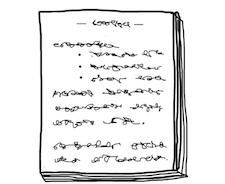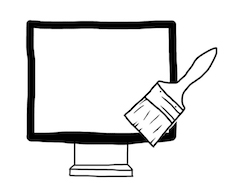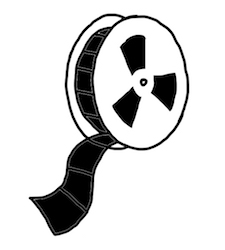By
Allie White
Whether you’re just starting out or have been in the game for years,
every actor needs a demo reel.
When it comes to the necessary parts of
an actor’s toolkit, your reel ranks up there with headshots and a
resume—it’s an essential piece of the career puzzle, your calling card,
the thing that lets the people in charge know who you are and why they
should hire you.
If you’ve got questions about how to approach creating your reel or how to update the one you already have, read on!

In short, a demo reel is a compilation of your (best)
work that shows your range in two minutes or less. It’s like an audition
without a script so that agents, casting directors, and producers can
see what you look like on camera and get a sense of your acting
abilities and on-camera presence. As such, your reel is often what
decides whether you’re asked in for an audition.
Why do I need a demo reel?
Casting directors don’t have time to waste. Other than
your headshot, your reel may be the only thing they look at before
deciding whether or not they want to bring you in, so it’s crucial that
your reel show off your skills and highlight the work you’ve done (or
are capable of doing).
According to
Lance Camarillo,
founder of Acting Out Studios, reels are an essential part of your
career. “You have the opportunity to showcase your best performances and
let others see what you look like on film,” he says. “With a demo reel,
you can show off your range of work with a quality production, and show
an agent or casting director what you would look like on TV or film.”
“From a casting perspective, there are two purposes for reels,” says session director, teacher, and Backstage Expert
Shaan Sharma.
“First and foremost, to see what professional work you have done, so we
know you’ve been vetted by other professionals in our industry and have
experience in speaking roles on professional sets. And if you don’t
have that, which none of us do when we first start, a reel will just
allow us to gauge your skill as an actor, which can easily be shown with
great self-taped auditions.”
In addition to showing off your acting skills,
Max Ghezzi,
founder of Killer Demo Reels, says that your reel should also create
“an emotional response that encourages producers to hire you.” This
doesn’t mean you should load your reel with tear-jerking scenes, but
instead with the best acting you’ve ever done on camera, the kind of
acting that will draw the viewer (aka casting and producers) to your
talent.
Ghezzi also says that producers and directors can
sometimes use reels as the tiebreaker between two actors: “Camera
presence, personality, command, style, attitude, consistency,
versatility, and experience in front of the camera are all scrutinized,
until one actor comes out the winner.”
And at the most basic level, casting directors who
utilize casting platforms like Backstage need only click a button to
filter out submissions who don’t have reels—that’s how important they are in the eyes of casting.
What should my demo reel include?

Your
reel should start with your personal information so the people watching
know who you are and how to get in contact with you. A few seconds of
your headshot, name, website, and contact info is all you need.
Then go straight into the very best, highest-quality
clip you’re including. It’s possible that casting only gets through the
first clip before deciding whether or not you’re right for a project, so
you want to lead with your best foot forward.
No need to introduce each clip—a simple line of text
at the bottom of the screen indicating the name of the project and/or
the genre is enough. Aim for a range of 4-5 clips, each 20-30 seconds
long, with the total run time of the reel being three minutes max.
Gary Zuckerbrod,
casting director and former Casting Society of America president, says a
reel should "have no montage, no flashy open, no music over somebody's
name for 14 seconds. The best demo reel…starts with your name and goes
immediately into a scene. Casting agents use the demo reel to identify
what qualities the actor has. It needs to be concise and tight."
How long should my reel be?

Remember
that the people watching your reel are also watching dozens (if not
hundreds) of other reels. You want to make sure yours contains enough
information for them to get to know your ability, but that it’s short
enough that they don’t get bored. So keep it short and sweet.
Acting coach
Joseph Pearlman
says, “A good reel should be no longer than one-and-a-half minutes and
start immediately; no 10-second holds on your name against a blank
screen—that just bores casting to tears and makes them impatient.”
Opinions vary on the exact length, but as long as your
reel is under three minutes (max!) and features two-to-five varying
scenes that showcase your abilities, you’re good.
And if you’re worried that the short length means the viewer may not understand the plot,
Joe Gressis
of Secret Handshake Entertainment says it’s important to remember that
“your reel is not a short film.
Reels are decontextualized by nature,
meaning that you cannot involve viewers in the story of your scene, no
matter how much you might want to. Viewers don't have to understand
what's going on in your scene; they only have to believe it.” So don’t
worry about setting the scene or making sure a viewer can understand the
plot, that’s not why they’re watching.
What are some key qualities of a great reel?

Though
the very specifics qualities can vary depending on who you ask, there
are definitely constants in terms of what makes a great reel. According
to our Backstage Experts, where’s what every great reel should have:
Acting teacher
Paul Barry
says, “A demo reel should highlight your most marketable qualities. It
should be an honest representation of how you look, sound, and act right
now.
Footage that obscures any of these features—and old
material—should be avoided at all costs.” He also notes that the sound
and vision quality should be high, and the acting should be your best.
Joe Gressis,
owner of Secret Handshake Entertainment, advises that every reel should
start with your strongest scene: “Don't save it for a big ending or a
surprise in the middle. Start with your best. It might be the only scene
they watch.:” (This is something you’ll have to talk to your editor
about if you choose to hire a professional.)
In that same vein, acting coach
Matt Newton
suggests getting an outside perspective on what your “best” scene is:
“You might think your acting is amazing in this one scene, but someone
else might disagree.”
Several Backstage Experts also emphasized the
importance of making sure all your relevant information is provided:
make sure to include a slate screen at the beginning of the reel that
contains your name, email address, and website, as well as labeling your
clips so viewers know what they’re watching.
And make sure all the clips you choose actually focus on you.
Make it as easy as possible for casting to know whose reel they’re
watching, so scenes should always start and end on a shot of you rather
than the other actors in the scene.
Do I need to hire a videographer?
Unless you have experience in the editing room—and
even if you do—it probably pays to hire a professional videographer.
“For people who are looking to really have a professional reel, I would
suggest going to a service like mine,” says New York-based videographer
and Backstage Expert
Tim Grady.
“You don’t have to worry about the lighting or the sound or the camera
quality. It’s super important to put yourself up professionally, so
invest a little bit of money to make sure that is what’s happening.”
Think
of this expenditure like an investment in your career: If you shell out
the money for a professional reel today, you’re that much more likely
to start booking jobs that will pay much more than what you paid for the
reel. That said, it’s important to make sure you can afford an expense
like this. Before you run to the videographer, make sure your finances
can take it. Check out some actor budget advice
here and
here.
In terms of finding a videographer, the best place to
start is asking your actor friends for recommendations. Maybe you’ve
seen a friend’s reel that you really liked or you overheard someone in
your acting class talking about how great the guy who worked on their
reel was. Don’t be afraid to inquire. And once you do get in touch with a
professional, ask questions. Make sure you know all the costs up front,
what the payment plan is, what they’ll need from you and what you’ll
walk away with.
Will they provide you with a digital copy or just
DVDs? Do you get a say in the order of the footage? How much will it
cost to edit new footage you shoot with them into clips from previous
roles?
If you’re really dying to edit your own reel
because you have a ton of editing experience, by all means, go for it.
The key to editing your own reel is to be objective enough to determine
what should be included and what needs to go.

Is
your acting stronger in the clip from that student film where the
lighting is weird or the immaculately-produced web series where you
don’t like the way your hair looks? You only have seconds to grab their
attention, so make sure you can recognize where and how to put your best
actor foot forward.
Retta Putignano, partner and head writer of Create Your Reel and Backstage Expert, has four tips for editing your own demo reel:
- Retain focus: “Share the screen as little as possible. Casting
directors, agents, and managers want to see you on your reel...It should
start and end with your face. Make it easy for the viewer to know who
they should be watching.”
- Hold their attention: “Keep the footage as succinct as possible. If a
scene goes on too long, you risk losing your viewer. More isn’t always
better.”
- Put your best footage first: “Don’t risk saving the best for last.”
- Don’t be afraid to trim footage: “The viewer doesn’t have time to
consider your character’s backstory, the plot, what happened before this
scene, or what’s going to happen after. Keep it short.”
How many reels do I need?
Is a reel like a headshot? Do I need multiple reels to
showcase the different types of characters I can play or will one
composite do?
The answer is yes and no. In theory, your reel should
include a variety of styles, characters, and genres to showcase your
range and ability, which means one reel could cover both comedy and drama.
That said, if you have the means and the footage, casting director
Marci Liroff
suggests having one for comedy and one for drama. “If I'm casting a
comedy, I want to view and show just your comedy footage and vice-versa.
If we want to see your range, we can always view the other reel, but I
find that most of the filmmakers I work with want to see just your
comedy footage if we're doing a comedy and don't want to wade through
all the drama footage on your reel.”
What if I don’t have any professional clips?

New to acting and don’t have film credits to fill a reel? You have a few options.
One is to employ a professional reel service that
writes scenes for actors to perform in front of the camera on a real set
with other actors. This footage is then edited down into demo-friendly
bites to help build up your reel.
Cathryn Hartt,
a Dallas-based acting teacher and Backstage Expert, says she routinely
does this for students to “‘fake’ demo scenes until they can accumulate
footage from actual jobs…. I bring in a small crew and set up shots that
look like they’re from a real movie.”
However, opinions seem to vary on whether these mock reels are worth it.
Joseph Pearlman
thinks writing and shooting your own stuff is much preferred, as he
believes “a professional can smell [mock reels] a mile away.” By
collaborating with friends and pooling funds to hire a good
cinematographer and sound person, you “take control of the content you
create rather than being beholden to the derivative whims” of others.
Another option, courtesy of acting coach and director
Matt Newton
is to get involved in student films. Since film students often have
access to some of the best equipment, the quality will almost always be
good enough to include on your reel.
And acting teacher
Rob Adler
doesn’t see anything wrong with filming your entry-level demo at home
“provided the acting is spontaneous, alive, and shows you at your best.”
What should I not include on my reel?
We’ve covered a lot of ground about what your reel should
include, but there definitely are certain things that have no place in
your reel. Remember to keep it short, and to only include a few clips.
Just because you have all the footage you’ve ever shot doesn’t mean it
should be in your reel. Don’t worry about the viewer understanding plot
and backstory—they don’t care.
If possible, don’t repeat projects. Try to have each clip you include be from a different show, film, or performance.
No clips from acting class. Even if your class
provides you with footage, that should only be used to help you study,
not to pad your reel. No matter how good your work in class is, you
won’t be competitive against actors who have professional clips.

No gratuitous violence or overly graphic footage. Acting career coach and Backstage Expert
Gwyn Gillis
says horror, sci-fi, and special effects-heavy scenes don’t fulfill
your agenda as an actor. “No A-list casting director or top agent wants a
client whose demonstration of talent consists of being pursued across
the mall’s parking lot by a maniac wielding a chainsaw or girls in the
forest at night being pursued by monsters and screaming.”
There’s also no need for an on-camera introduction;
all of the necessary personal and contact information should be included
in a quick slate at the beginning or end of your reel, and then go
straight into the first scene.
No CDs or flash drives—would you plug a mysterious
flash drive into your own computer? Than why would someone who doesn’t
know you? Put your reel online and make sure you also have a compressed,
easy-to-send video file.
And please, make sure the footage you’re choosing to
include is relevant and recent. No clips from 20 years ago: you should
look like you in a reel. Casting will not be pleased if they
bring you in and you look nothing your reel because you used decade-old
footage. Same thing goes for type.
Now what do I do with my reel?

Ok!
You’ve got a reel. That’s great. Now what do you do with it? Get it
online! Upload that reel to your website (every actor should have a
website!), YouTube, and/or Vimeo. Make sure it’s on the front page of
your site and it’s clearly labeled as your reel.
You’ll also want to have the file saved as a
compressed, easy-to-send video file that you can shoot off in an email
if necessary.
What’s worse: No reel or a bad reel?
As the saying goes, you only get one chance to make a
first impression, so don’t rush it. If you don’t have enough footage in
general or enough footage you’re proud of to make a minutes-long demo
reel, that’s probably a good indication that you’re not ready to be
submitting to projects that require a demo reel.
“Do not make the mistake of getting a reel together before you are ready,” says
Paul Barry.
“Products rushed to market with technical and design flaws or
substandard branding are often viewed as inferior and to be avoided.
Don’t let this happen to your own products: you and your talent.”
What’s a “sizzle reel”?
As far as actors are concerned, a “sizzle reel” is
just another name for a demo reel. You can use them interchangeably, so
take note of who uses which term so as not to confuse yourself or anyone
else.












 Your
reel should start with your personal information so the people watching
know who you are and how to get in contact with you. A few seconds of
your headshot, name, website, and contact info is all you need.
Your
reel should start with your personal information so the people watching
know who you are and how to get in contact with you. A few seconds of
your headshot, name, website, and contact info is all you need. Remember
that the people watching your reel are also watching dozens (if not
hundreds) of other reels. You want to make sure yours contains enough
information for them to get to know your ability, but that it’s short
enough that they don’t get bored. So keep it short and sweet.
Remember
that the people watching your reel are also watching dozens (if not
hundreds) of other reels. You want to make sure yours contains enough
information for them to get to know your ability, but that it’s short
enough that they don’t get bored. So keep it short and sweet. Though
the very specifics qualities can vary depending on who you ask, there
are definitely constants in terms of what makes a great reel. According
to our Backstage Experts, where’s what every great reel should have:
Though
the very specifics qualities can vary depending on who you ask, there
are definitely constants in terms of what makes a great reel. According
to our Backstage Experts, where’s what every great reel should have:
 Is
your acting stronger in the clip from that student film where the
lighting is weird or the immaculately-produced web series where you
don’t like the way your hair looks? You only have seconds to grab their
attention, so make sure you can recognize where and how to put your best
actor foot forward.
Is
your acting stronger in the clip from that student film where the
lighting is weird or the immaculately-produced web series where you
don’t like the way your hair looks? You only have seconds to grab their
attention, so make sure you can recognize where and how to put your best
actor foot forward. New to acting and don’t have film credits to fill a reel? You have a few options.
New to acting and don’t have film credits to fill a reel? You have a few options. No gratuitous violence or overly graphic footage. Acting career coach and Backstage Expert
No gratuitous violence or overly graphic footage. Acting career coach and Backstage Expert  Ok!
You’ve got a reel. That’s great. Now what do you do with it? Get it
online! Upload that reel to your website (every actor should have a
website!), YouTube, and/or Vimeo. Make sure it’s on the front page of
your site and it’s clearly labeled as your reel.
Ok!
You’ve got a reel. That’s great. Now what do you do with it? Get it
online! Upload that reel to your website (every actor should have a
website!), YouTube, and/or Vimeo. Make sure it’s on the front page of
your site and it’s clearly labeled as your reel.











